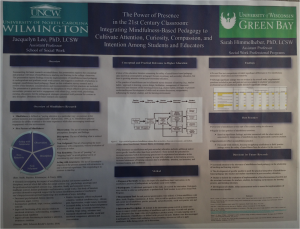Several recent campus conversations have focused on facilitating difficult discussions with students in and out of class. I’ve long taught multicultural American literature and women’s studies courses, so I appreciate how hard it is to effectively navigate these moments. As I prepare my syllabus for next semester, I’ve been thinking about the potential for mindfulness to help with these situations.

"The Power of Presence in the 21st Century Classroom: Integrating Mindfulness-Based Pedagogy to Cultivate Attention, Curiosity, Compassion, and Intention Among Students and Educators" by Jacquelyn Lee and Sarah Himmelheber
I then remembered that, before Thanksgiving, I wrote about the first of three conference presentations on mindfulness and learning I saw this semester. The second offers some insight on the connection between mindfulness and dealing with difficult topics with students In early October, I attended the conference of the International Society for the Scholarship of Teaching and Learning (ISSOTL) in Raleigh, NC. The poster session featured one titled “The Power of Presence in the 21st Century Classroom: Integrating Mindfulness-Based Pedagogy to Cultivate Attention, Curiosity, Compassion, and Intention Among Students and Educators” by Jacquelyn Lee and Sarah Himmelheber, social work faculty members at University of North Carolina Wilmington and the University of Wisconsin-Green Bay, respectively. Their study was broader than Nina Johnson’s focus on finger labyrinths in that they used a variety of tools:
- an introductory lecture on mindfulness and its relevance to their learning and practice of social work,
- varied practices at the beginning of each class for 12 weeks,
- recommendations for 2-minute meditation and breathing exercises, and
- mindful approaches to journal writing and class discussions.
Their pre- and post-test study in both undergraduate and graduate social work courses documented significant increases in both observation (“The act of noticing sensations, perceptions, thoughts, and feelings”) and non-reactivity (“The act of ‘pausing,’ or ‘stepping back’ to avoid getting lost in or overtaken by one’s inner experience”).
I can easily see the importance of observation and non-reactivity in social work, but these findings are important for others as well. I think back on all of the challenging, emotionally charged discussions that have been important in my courses and in my office-hours conversations with students. Zitkala-Sa, N. Scott Momaday, Louise Erdrich, and Indian relocation. Olaudah Equiano, Frederick Douglass, Toni Morrison, and slavery. Stephen Crane, E. E. Cummings, Tim O’Brien, and war. Harriet Jacobs, William Faulkner, Richard Wright, Octavia Butler, and rape. And I could go on. Difficult issues abound in what I teach, and we have to talk about them–really talk about them–in class, and these conversations inevitably spill over into office hours as well. Prohibiting, avoiding, or ignoring them means I’m not teaching my discipline fully, and I’m not teaching to the whole student.
We talk a great deal about having a “safe classroom environment” for learning. What do we mean by that, and how can we create it? How do we describe it and teach it to students? Such self-awareness (observation) and calm (non-reactivity) seem critical to these “hot moments” but aren’t automatic or even readily available to all. Lee and Himmelheber’s study suggests that a more mindful classroom may help us–and more importantly, help the students–create this kind of learning environment. In our syllabi, we have  statements of the kind of classroom environment, participation, and engagement we expect. I’m going to work on how clearly I describe what these look like, and how I help students get there. I just came across some passages that may be helpful. I’ll share some examples by the start of next semester.
statements of the kind of classroom environment, participation, and engagement we expect. I’m going to work on how clearly I describe what these look like, and how I help students get there. I just came across some passages that may be helpful. I’ll share some examples by the start of next semester.
Practice
Here is an initial step for encouraging a mindful (fully present, focused on what’s happening in the room, open to what emerges with minimal knee-jerk reactions) approach to individual discussions and to overall classroom environment. Tan (2012) describes the way he chairs meetings:
“I invite everybody in the meeting room to make the following assumptions about everybody else:
- Assume that everybody in the room is here to serve the greater good, until proven otherwise.
- Given the above assumption, we therefore assume that none of us has any hidden agenda, until proven otherwise.
- Given the above assumption, we therefore assume that we are all reasonable even when we disagree, until proven otherwise.” (p. 180)
He asserts that this initial step brings “a greater sense of trust in the room.” The next time you enter a conversation that may be challenging, experiment with these ground rules by introducing them to the group. Tailor them to your context. Think about how you might adapt them to your syllabus and your classroom.
—



